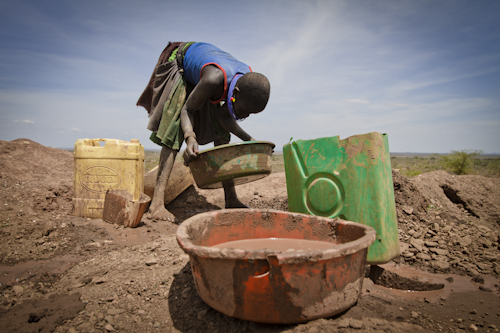
For Talabem Lokwii working on the Rupa gold mine is a family affair. Every morning he clambers about 15 feet down the perilous looking hole he has hewn for himself out of the dusty hillside. Chiselling away for hours on end in the darkness below, he emerges from time to time with plastic containers filled with orange earth he prays will contain at least a dollar or two's worth of gold.
While Talabem, who says he is about 40, is at work underground, his wife Teresa and teenage son Korii are making the seven-mile round trip to the nearest borehole to collect water to wash the earth and sieve out the gold. Sitting on the edge of the pit, his daughter Angela, who her parents say is about six, is responsible for the washing; a painstaking process to try and turn the piles of earth her father digs out into a few specks of gold.
"I love my job," Angela says, as she hunches over her washing basin. "I want to get something for survival and for my family."
On a good day, Talabem says they can make just over two dollars. With that money he is sending the family's two other children to school, caring for newborn baby and occasionally managing to buy enough food for them to eat.
Talabem's pit is just one of hundreds that stud the hillside around Rupa. Local activist Simon Nangiro estimates that about 10,000 people survive off the Rupa site alone. In total, double that number depend on gold mining across Karamoja, and that doesn't take into account those living off the gemstone, marble and limestone deposits that dot the countryside.
Once cattle-keepers, locals have increasingly turned to mining over the past few years after they say government disarmament operations left them vulnerable to raids from neighboring clans.
"The gold has become for us now what our cows used to be," Talabem says. Working underground can be potentially fatal. As I wander around the site under the midday sun, almost everyone I stop to talk with has tales of brothers, cousins, friends lost or injured in accidents.
With lengthening droughts in the region making farming unsustainable and almost nothing in the way of other industry or jobs, the people here say they have little option but to risk their lives in the mines.
Talabem says he's got other worries, however. As the government's disarmament campaign has improved security in the region, so interest from foreign speculators has risen, locals say.
Part of the problem is that no one really knows the extent of Karamoja's mineral wealth. A 2009 aerial survey of Uganda's mineral riches didn't include Karamoja due to security concerns. The government has promised a survey of Karamoja, but it hasn't come yet.
In the meantime, the local miners are living in fear and ignorance that someone could move in and kick them off the land, and activists are concerned that it could spark renewed conflict down the road.
"It is about transparency because the fear we have is that we don't hear enough from the government side. What is being kept from us?" local activist Nangiro says.




